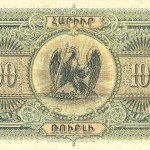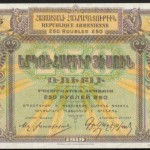The First Republic of Armenia was founded on May 28, 1918. The necessity to have own currency arose for the stability of the economic state of the country. However, because of lack of necessary printing in the country it was determined to print bank-notes of the First Republic abroad. Originally it was decided to print them in Paris, but because of poor quality the printing of banknotes was entrusted to publishing-house “Waterloo and Sons” in London which carried out the job.
Because of short life of the First Republic which lasted only 2,5 years the bank-notes were not put into circulation, but they still remain the interesting samples of Armenian painting due to their design and high artistic value. The author of illustrations of the bank-notes is prominent Armenian artist Arshak Fetvachyan who remaining loyal to Armenian national painting, created really valuable samples. The bank-notes of value of 50, 100 and 250 roubles portray the emblems and features peculiar to Armenian culture. The bank-notes of 50 roubles worth were designed according to Armenian architectural style, the peculiar features of which are ornamental decoration of the front, the images of fantastic animals:
dragons, griffons, presenting the decorations of ancient Armenian temples. The bank-note of 100 roubles worth was illustrated in accordance with the principles of Armenian miniature: stylized birds, rich design that resemble lace and so on. Mount Ararat and an eagle hitting a snake by a sword were also portrayed on these banknotes. This emblem was adopted in Armenia still before the rule of Arshakyan Dynasty. The bank-note of 250 roubles worth was decorated in the front with the images of griffons, symbols of eternity, angels holding a lamp in one hand and a sword in the other, who win the monster, and a woman dressed in national dress (taraz) spinning a winch was portrayed on the opposite side of the banknote. Though not being applied in their sense, these banknotes played an important cultural role. With their illustrations they became an integral part of Armenian painting; and now they are exhibited in various museums as the samples of cultural life of the time.
Bank-notes (drams) of the first Armenian Republic
Back To Top












